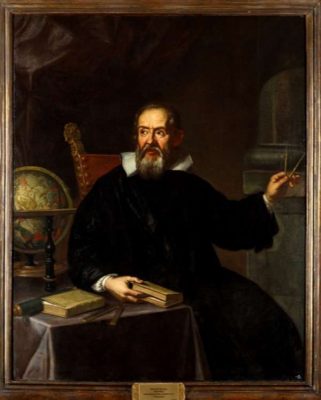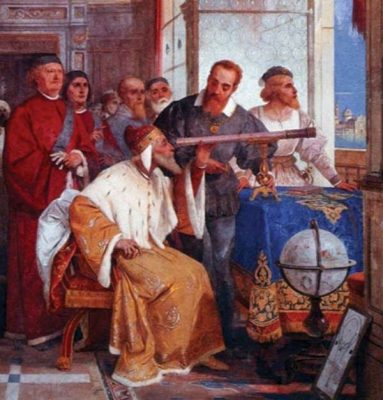Galileo Galilei was a famous physicist, astronomer, mathematician and philosopher of Italy. During 14th and 17th centuries, he made some revolutionary discoveries in the field of physics and astronomy. Due to his remarkable achievements, Galileo is rightly regarded as the father of observational astronomy. In the field of astronomy, he discovered the four largest satellites of Jupiter; he proved through his telescope the phases of Venus for the first time; and he also observed the sunspots. He invented several instruments like geometric and military compass. At the age of eight years, the family of Galileo traveled to Florence. For the next two years, he stayed with Jacopo Borghini. One of his ancestors was Galileo Bonaiuti, who was a teacher as well as physician in Florence. He lived in the 14th century. The family of Galileo changed their surname to pay respect to him. Previously, their family names ended on Bonaiuti. For that reason, the surname of Galileo comes from his first name. Let’s dive deep into his life in Galileo Galilei facts for kids!
A Quick Guide to Galileo Galilei Facts for Kids
Year and Place of birth: 1564 in Pisa, Italy
Father: Vincenzo Galilei (Italian lutenist, music theorist and composer)
Reason for Fame: Remarkable discoveries in Physics and Astronomy
Title: Father of observational astronomy
Discoveries: Four largest satellites of Jupiter, phases of Venus and sunspots
Inventions: Geometric and military compass
Fascinating Galileo Galilei Facts for Kids
- He took earlier education in Camaldolese Monastery at Vallombrosa near Florence.
- In order to earn medical degree, he attended the University of Pisa.
While studying medicine in 1581, he witnessed the swinging movement of bronze chandelier moving back and forth in cathedral of Pisa. What he actually observed was that (irrespective of the amplitude) the pendulum took about the same time in to and fro direction. He calculated this movement with his pulse. He took two pendulums in his home, experimented on them and found the same result.
- Galileo had to study medicine because physicians at the time earned higher income.
- He attended a class on geometry not on purpose and later asked his father to allow him to study mathematics.
Galileo Galilei Accomplishments
- At the University of Padua in 1592, Galileo taught mechanics, geometry and astronomy for about 18 years. It was during this time when he made famous discoveries in science like kinematics of motion.
- He invented a device which could note down the changes in temperature as the liquid inside it rises and falls accordingly. This device was known as thermoscope and set the tone for the creation of thermometer.
- He was among one of the first thinkers of modern science to state that laws of nature are mathematical.
- In 1609, Galileo created a telescope having 3 x magnification. Later on, he increased its magnification to 30 x. This telescope is called spyglass or terrestrial telescope.
- By means of his telescope, Galileo discovered three of the four largest moons of Jupiter on January 7, 1610. At first, he called them ‘three fixed stars, totally invisible by their smallness’ but after three days, one of them vanished. After another three days, he observed the fourth moon. He called all of these moons Medicean stars. These moons are now named as Galilean satellites because of its discoverer.
- The discovery of Jupiter’s moons was a revolution in astronomy because at the time it was believed that every object in space orbits around the earth.
- In the middle of 1611, Galileo was able to figure out the periods of these moons accurately. Johannes Kepler could not believe it.
- Like our moon, Venus also exhibits full sets of phases. This was first illustrated by Galileo in September 1610.
- The astronomical observations of Galileo disproved the geocentric model of Ptolemy, which suggested planet earth as the center of solar system and all heavenly bodies circle around it.
- He observed the planet Saturn along with its rings. However he thought the rings of Saturn were actually planets and remained confused.
- In 1612, he observed the planet Neptune. But he could not figure out that it was a planet instead he believed it was one of the dim stars.
- He is one of the first Europeans to witness sunspots. Before him, Kepler also spotted sunspots in 1607 but he confused it with transit of mercury.
- Galileo described for the first time that because of the light occlusion from craters and lunar mountains, the moon experiences uneven waning.
- In 1617, he witnessed the double star called Mizar in Ursa Major.
- He spotted the Milky Way as a densely packed collection of stars that looked a lot like clouds from our planet.
- He developed a method by means of which the apparent size of the star can be calculated without seeking help from a telescope.
- He is the pioneer to figure out sound frequency.
Galileo works provided the foundation for Newton’s laws of motion as well as special theory of relativity by Einstein. He concluded that there is no absolute motion or rest and that laws of physics are always the same.
Learn now: Issac Newton Facts for Kids
During his house arrest, Galileo produced one of the remarkable works on science; Two New Sciences. This was his final book published in 1638 and he gave account of his works that he did 40 years earlier on the strength of materials and kinematics. Albert Einstein also applauded this book. This work awarded Galileo the title of ‘Father of Modern Physics’.
Galileo Galilei Facts about his Life
- With the help of his theory of the tides, Galileo showed that Earth and other planets revolve around the static sun. Thus, he proved that the model developed by Nicolaus Copernicus in 1543 was true. Although he was right about the movement of earth around the sun, he could not figure out the cause of tides correctly. According to his theory, there should have been one high tide daily instead of two.
- Galileo did not accept the idea of Johannes Kepler that moon was the real reason behind tides. Besides, the elliptical orbits of planets described by Kepler also did not appeal to Galileo.
- At the time, the protestant leaders rejected the idea of heliocentrism (model of astronomy in which earth and other planets orbit the sun). They had a strong belief that earth is the center of the universe and all planets revolve around it (geocentrism). In 1609, Galileo supported heliocentrism based on his observations.
- In 1613, the Grand Duchess Christina of Florence argued that heliocentrism was against the biblical texts. But Galileo replied that Bible was not a book on science but on morals and faiths.
- Due to Galileo’s beliefs that earth moves around the sun (heliocentrism), Father Niccolo Lorini felt that he was going to reinterpret the Bible and thus Galileo was presented before Roman Inquisition to defend his views.
- Due to his views on heliocentrism, Galileo became ‘vehemently suspect of heresy’ and he was kept house arrest for the rest of his life. It is thought while he was forced to change his beliefs and had to concede that all the planets revolve around the motionless earth; he spoke silently to say the following famous words:
And yet it moves
- By 1638, Galileo became blind due to insomnia and hernia.
Galileo Galilei Death
- At the age of 77, Galileo died on 8 January 1642.
- Galileo was buried in Basilica of Santa Croce in Florence. It is the same church where his ancestor Galileo Bonaiuti was buried 200 years earlier.
- Since Galileo was condemned by the Catholic Church, Pope Urban VIII did not allow him to bury at the main body of Basilica of Santa Croce.
- In 1737, he was reburied at basilica’s main body and a monument was built in his honor. While doing this, one tooth and three fingers of Galileo were shed. Today, his right-hand’s middle finger is on display at the 11th century building called Museo Galileo in Florence.


Leave a Reply